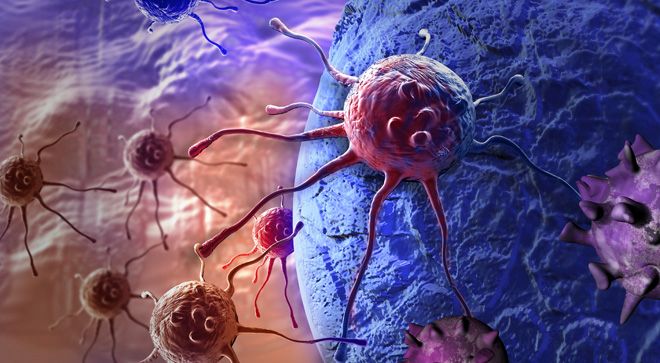Publication
Article
CURE
Appendix Cancer: An Elusive Diagnosis
Author(s):
Often uncovered by accident, appendiceal cancers trigger few symptoms until they’re advanced and can be difficult to detect and treat.
Elizabeth Ames knew something wasn’t right. Feeling increasingly bloated and full, the busy Atlanta attorney and mother of two figured she just needed to clean up her diet.
She was wrong. “It got to a point where it was noticeable and not normal,” Ames says. She visited her primary care doctor, and a preliminary exam and blood tests showed nothing out of the ordinary.
But Ames didn’t let it go. With a scheduled hernia surgery on the horizon, she wanted answers. She saw several specialists, starting with a gastrointestinal doctor, who suspected a bacterial overgrowth. Not satisfied with that explanation, Ames consulted her gynecologist, who did a sonogram and found fluid in her abdomen. Within an hour, Ames was in a surgeon’s office.
Still, definitive answers remained elusive. The surgeon was “95% sure” the fluid was related to her existing hernia, according to Ames, who asked, “How do we get to 100% sure?’”
A CT scan revealed the answer. “We did the scan and to his surprise, it was not a hernia,” Ames says. “It was cancer.”
At just 38, Ames received a diagnosis of stage 4 high- grade appendix cancer. Her type: adenocarcinoma with the pseudomyxoma peritonei syndrome.
UNCOMMON TUMORS, NUMEROUS TYPES
Appendiceal cancers are rare, with 1,500 to 3,000 new cases each year in the United States, according to Dr. Kiran Turaga, a surgical oncologist at UChicago Medicine. “Appendix cancers have been poorly understood over many decades,” he says. “When we use the words ‘appendix cancer,’ that usually comprises a heterogeneous group of tumors.”
Broadly, appendix tumors, or masses, include neuroendocrine tumors, sometimes known as carcinoid tumors, are composed of malignant cells that sometimes produce hormones that can go throughout the body. About half of all tumors found in the appendix are neuroendocrine tumors, which tend to grow slowly and are typically removed successfully during surgery.
Adenocarcinomas grow in the epithelial tissue, or lining, of the appendix. According to Turaga, some of these tumors form glands and behave like colon and other types of cancer, sometimes spreading to lymph nodes and other parts of the body.
Within the appendix, epithelial cells produce mucin, a jellylike substance containing proteins that forms a barrier to protect the intestinal lining. Appendiceal epithelial neoplasms, or tumors, can prompt the cells to over- produce mucin, causing the appendix to become “like a little balloon,” Turaga says. When these tumors rupture, mucin fills the abdomen and can lead to a potentially fatal condition called pseudomyxoma peritonei, in which mucinous tumor cells fill the abdomen and pelvis and can coat and constrict organs.
Appendiceal adenocarcinomas are classified as either low, intermediate or high grade, depending on the histology, or how the tumor appears under a microscope, according to Dr. John Paul Shen, a physician scientist in the department of gastrointestinal medical oncology at The University of Texas MD Anderson Cancer Center in Houston.
“All cancer looks different from normal cells under a microscope,” he says. “Cells that look reasonably similar to normal tissue are classified as low grade. These are cells that should form glands, and you can see that the cells are trying to do that. (Although) they’re abnormal, the cells are behaving in a lot of ways like the normal tissue they started from. We call that cancer well differentiated.”
High-grade, or poorly differentiated, cells are unlike the normal tissue. “They have lost all the normal signals that a cell would have. They tend to grow faster, and in appendix cancer, you have a worse prognosis,” Shen says.
Other types of highly aggressive appendix cancers include signet ring cell adenocarcinoma and ex-goblet cell adenocarcinoma (adenoneuroendocrine).
FEW CLEAR CLUES
One of the challenges of diagnosing appendix cancer is its lack of symptoms. By the time symptoms appear from appendix cancer and pseudo- myxoma peritonei — in some cases, years after undetected growth — the condition can be quite advanced.
Appendix cancer is usually diagnosed incidentally, discovered while a person is being tested or treated for another condition, according to Dr. Charles Staley, chief of the division of surgical oncology at Emory University School of Medicine in Atlanta. “(For example,) you’re scanning somebody for a kidney stone and you find a mucinous mass in the appendix,” he says. Sometimes a pathology report after appendix surgery confirms cancer.
Doctors can’t count on CT scans, ultrasounds or MRI in diagnosing appendix cancer. “Unlike breast cancer or colon cancer, there’s no screening modality for it,” Turaga says. “And, when appendix tumors spread, they tend to spread along the lining of the belly cavity called the peritoneum. Think of it like a room with paint on the walls. There’s a lot of paint, but it’s very thin. When you have a CT scan, you can only see objects that have a big masslike discrimination, like the liver or the spleen — like a table or chair in the room.”
For many people, like Ames, bloating is the first sign that something is wrong. That was also the case for Jerry Lewandowski, 46, of Bethesda, Maryland, president of the Appendix Cancer Pseudomyxoma Peritonei Research Foundation. In late 2007, at age 33, he felt an unusual tightness in his belly. “When I leaned over to tie my shoes, I couldn’t do it without a lot of discomfort,” he says. His concern led him to the emergency department, where a sonogram showed liters of fluid in his abdomen. A CT scan and exploratory laparotomy — a surgical incision into the abdomen — confirmed a diagnosis of stage 4 low-grade mucinous neoplasm of the appendix.
STAGING AND SURGERY
Treatment depends on how the cancer is staged and graded, which can be challenging. “Staging of this disease is extremely archaic,” Staley says. “Any tumor that has ruptured is stage 4,” which is precisely the point at which many people are diagnosed.
Tumor volume can be staged during surgery using the peritoneal cancer index, Staley says: “Basically, we divide the abdomen into nine quadrants, like a tic-tac-toe board. Each square gets a score from zero to three, depending on whether there’s no tumor or the size of the biggest cancer nodule in that quadrant.” A similar method is used to score the small intestine.
“Your score can be anywhere from a zero to 39,” he says. “That’s how we score the volume and amount of cancer in people’s abdomens.”
Surgical removal of the tumor and some surrounding tissue is the most common treatment for appendix cancer. Surgery types include appendectomy, removing the appendix and local tissue; hemicolectomy, removing a small portion of the colon near the appendix, some- times with accompanying blood vessels and lymph nodes; and cytoreduction, also known as debulking, removing as much of the tumor(s) as possible.
Chemotherapy prior to surgery is rarely used for low- grade mucinous neoplasms because they typically don’t respond to it, according to Staley. “For people with high- grade tumors, we may give them some chemotherapy before surgery, anywhere from three to six months,” he says.
Ames received a three-month course of chemotherapy prior to what she calls a “whammy of a surgery.” Staley, her surgeon, removed her appendix along with half her colon, her gallbladder and spleen, three stomach arteries and her omentum. She also had a full hysterectomy. “Fortunately, my small intestine was not covered in tumors,” she says. “But everything else was.”
During the surgery, Ames also had hyperthermic intraperitoneal chemotherapy (HIPEC), in which chemotherapy agents heated to 108 degrees Fahrenheit are delivered to the abdominal cavity immediately following cytoreductive surgery. Chemotherapy circulates through the abdominal cavity in a closed system on a modified bypass machine.
Therapy for low-grade mucinous neoplasms has been the same for the last 20 years, according to Staley. “That’s complete cytoreduction, where you remove all the cancer you can visibly see throughout the peritoneal cavity, along with removing the appendix. Then we wash the abdominal cavity out with a hot chemotherapy agent to kill any microscopic tumor cells that are floating in the abdominal cavity,” he says.
When making treatment decisions, Turaga says, it’s important to consider both the patient and the disease. “I ask, ‘Who is the patient and what are their wishes? Are they healthy? Are they fit?’” he says. “Second is the disease itself. What really matters is the pathology. That’s why it’s so important that slides are reviewed by a pathologist who’s experienced in this. Because appendix cancer is so rare, many pathologists might see only one or two in their career.”
EXPERTISE MATTERS
Doctors and patients agree that for rare cancers, an experienced team is critical. Lewandowski said his wife, Karolyn — they were dating when he was diagnosed — researched not only treatment options but also doctors. He had a peritoneal cancer index score of 39 (out of 39) and was treated with surgery and HIPEC in January 2008, followed by another surgery with HIPEC after a recurrence a year later. His pathology showed a mix of low- and high-grade cancer, so he was treated with systemic chemotherapy following his second surgery. In March 2010, Lewandowski had a third recurrence, with another surgery and HIPEC.
“It’s really important to get the right treatment from an appendix cancer specialist and get it early in the process,” he says. “And it’s important to be engaged in the process to find the right specialist.”
Carolyn Langlie-Lesnik of Crown Point, Indiana, founder of the Appendix Cancer Connection, Inc., received a diagnosis of stage 4 signet ring cell appendix cancer 19 years ago, at age 41, after her appendix ruptured. “I tell people who are newly diagnosed that the No. 1 thing they need to do is find a specialist who knows appendix cancer,” she says.
An expert also can help you access clinical trials and preclinical research. Shen is involved in research looking at potential targetable mutations in appendix cancer. “In low-grade appendix cancer, we know that one of the most commonly mutated genes is called GNAS. Right now, we don’t have any drugs against that, but we think it’s a potential candidate,” he says. “We’re also looking at how that gene signals, so if we can’t target a drug against the gene itself, there are a lot of other links in that chain that we could hit with drugs. That’s something we are actively testing in the lab.”
Repurposing existing drugs in the fight against appendix cancer is a research focus, according to Shen.
“We’re looking at trying medicines in the taxane family,” he says. “They’re commonly used in breast cancer and have been shown to work in small bowel cancer. Because appendix cancer tends to be more similar to a small bowel cancer, these drugs could work in appendix cancer.”
Lewandowski’s second surgery and HIPEC included the use of heated melphalan, a drug commonly used for multiple myeloma treatment and for which many specialists have seen positive results with appendix cancer.
Staley says molecular gene testing may be done in patients with higher-grade tumors like signet rings and adenocarcinomas, but that’s a smaller group. For most appendix cancers, there is no targeted therapy.
As knowledge grows, treatment and management of appendix cancers is evolving. A multidisciplinary working group released the Chicago Consensus on Peritoneal Malignancies: Management of Appendiceal Neoplasms, published in April 2020 in two journals simultaneously, Cancer and Annals of Surgical Oncology. “These are new treatment guide- lines and protocols that are a good framework,” Turaga says.
Ultimately, Ames says, it’s critical to be your own advocate. “The rarer the disease, the more important it is to find an expert,” she says. “Ask those hard questions of your doctor. Ask how many of these surgeries they’ve done and how many times they’ve seen this type of cancer. Make them sell you that they’re the right doctor. This is your life.”






